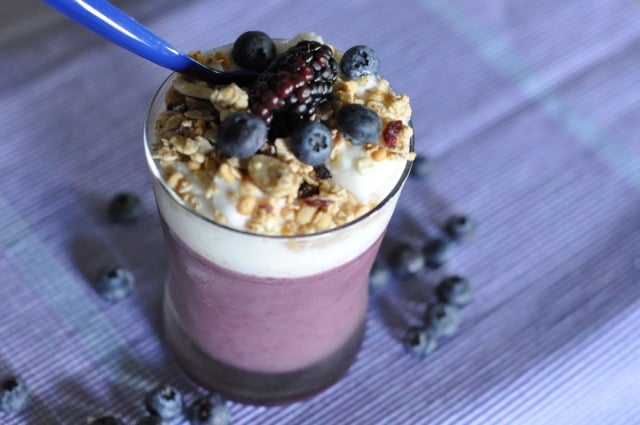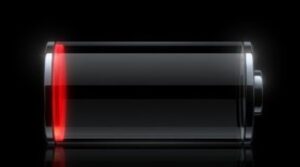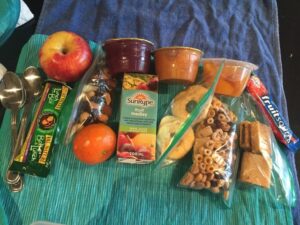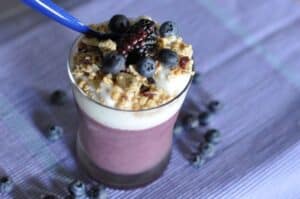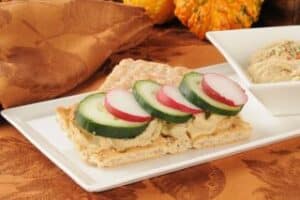Are you one of the 90% of Canadians who could benefit from up-scaling your snack?
If your body’s energy is like a cell phone, what percent battery life do you have by the end of the day? Many people are around 5-10% by the end of the day, leaving them with extremely low energy to do much more than flopping on the couch, about ready to shut down for the day. Forget about cooking supper or much of anything else!
Almost half of Canadians say that eating a balanced diet is challenging for them because they are so busy. Busy, over-whelmed, tired, over-worked, over-committed, exhausted.
We all know that food helps us fuel our day. Food helps charge up our body’s battery (as does restorative sleep). Yet, 37% of Canadians say they skip meals, replacing 1 – 2 meals/day with snacks (1). One in five Canadians say they eat between-meal snacks several times a day, preventing them from eating meals at regular “meal” hours (2).
Over the last 3 years, consumers report snacking between meals more often (1), with close to 30% of Canadians say they snack to stay fuelled in a busy day (2). Snacking occurs most often in the afternoon (1). Women and single consumers are the groups more likely to skip lunch, and more likely to snack compared to all demographics (2).
Let’s explore snacking a little further.
What counts as a snack? Depends on who you ask
Consumers define snacks by time of day when the snack is eaten (i.e. during non-traditional meal hours) and also by item size (1). According to dietitians and researchers, snacks are foods or drinks that are consumed between meals (2).
What kinds of foods do Canadians report snacking on?
- In a month, the average Canadian enjoys 12 different types of snacks.
- Nine of 10 Canadians – the vast majority – snack on a variety of foods including salty snacks, cookies, crackers, jerky, fruit, nuts and confectionary.
- Preferred snacks by category include beverages, baked goods, dessert items, appetizers or small or full portioned entrée items.
- Other non-traditional foods consumed as snacks include toast, eggs, breads, cereal, vegetables, pizza, soup and salad (1).
Why do people snack?
The following reasons are reported as driving Canadian snacking behavior (1):
- Time constraints. Who isn’t struggling with a lack of time? I have too much time on my hands….said no one ever!
- Desire for convenience. Who has time for elaborate and messy snacks? Please! Someone, do the thinking for me, so I can power through my chaotic day!
- Mood. Snacking occurs in response to mood, be it positive (happy) or negative emotions (stressed, anxious or sad). A snack can be an inexpensive form of escapism. And hey, there are worse ways to escape!
We are busier than ever AND we still need to eat!
Snacking can be part of a healthful diet and can be a way of helping your body to get all the nutrients it needs each day (2). More skipped meals, which results in more snacking, means that we may want to pay more attention to the kinds of snacks we choose.
When there is a consumer need (for example, time, convenience, a desire to influence our mood), the food industry will respond with food and snack options, which further changes the food environment in which we make food decisions.
The keys to healthful snacking are:
- choose nutritious foods,
- match portion sizes to hunger and energy needs, and
- differentiate between snacks versus treats.
Here is how you can upscale your snack
- Make your snacks convenient, available and tasty. These are the most important drivers of snack choices (1).
- Plan ahead for snacks – we think of bringing food when we have young children in our lives. And then we gradually lose this habit (2). Start packing your snack the same way you pack your work or workout bag.
- Portion sizes – human behaviour is to finish the bag or the box! Take out a portion and put it on a plate or a bowl (2) rather than snacking directly from a box or package.
- Listen to your hunger cues – are you physically hungry? Or is your heart hungry, resulting in you eating because you are bored, tired or stressed? Both kinds of hunger are perfectly normal and okay. If snacking to feed your emotional hunger is your only way to satisfy this need, you may benefit from expanding your tools to help meet your needs and your health goals (2).
- Skip the distracted snacking! Slow down while eating. How are you eating? Are you frantic? Eating while working or breezing through social media? Take a few minutes, take a few deep breaths, and stay present while eating your snack.
- Notice on what do you want to snack? Pay attention to what you actually want to eat during the day. Snacking on vegetables is something I feel like doing in the morning and just before dinner. However, my mid-afternoon snack tends to steer me away from veggies and more toward energy balls, or something sweet/salty. Notice what it is that you have an appetite for during snack times.
Fuel and recharge your body with snacks that are fast, convenient, and satisfying
Food offers the potential to fuel! We can stay energized by planning nutritious snacks into our day (2). Change your own food environment with snacks that are fast, convenient, and satisfying
Consumers want snacks that are fresher, less-processed items, high in protein and fiber, contain antioxidants and are energizing and stress relieving (1).
Here are a few snack ideas to get you started!
- Red bell peppers and snap peas served with a lemony hummus. Experiment with different flavours (and colors!) of hummus.
- Greek yogurt and frozen blueberries + honey
- Greek yogurt cup and grapes
- Sliced up pear with peanut butter
- Apple wedges with sliced cheese
- Small handful of cashews with dried fruit
- Pumpkin banana mini muffin with a decaf, non-sweet latte
- Popcorn with roasted chick peas
- Tuna with crackers
- Cracker nachos: whole grain crackers with melted cheese.
- Blueberry smoothie: ½ cup frozen blueberries, ½ banana, ½ cup Greek yogurt, ½ cup milk, small handful of fresh mint.
- Mandarin orange with a small handful of pistachios.
- 30 g whole grain cereal with 1 tbsp raisins and 1 tbsp nuts
- Energy balls with a cup of tea.
Click here for more snack ideas.
I’m so excited to be part of this year’s Dietitians of Canada Nutrition Month 2019 Campaign where we helping Canadians Unlock the Potential of Food! If you need help unlocking the potential of food to fuel your best health, contact myself or another dietitian. Happy Nutrition Month!
Related post:
- Snacking – should you or shouldn’t you?
- Healthful snacks to pack on a road trip
- Snack ideas for after school sports (from parents living in the trenches)
- Maintaining your diet and lifestyle on the weekend
- Should you use a meal kit service? My meal kit review
References:
- Competitiveness and Market Analysis Section, Alberta Agriculture and Forestry. Consumer Corner. Issue 48; Jan 2019. Snack Food. Available from:
2. Dietitians of Canada. Member Resource Manual. 2019. Unlock the Potential of Food. Available from: NutritionMonth2019.ca [login required].
Tagged in: Calgary Dietitian, Calgary Nutritionist, healthy snack, healthy snacking, healthy snacks, Nutrition Month, Nutritionmonth2019, snack ideas, snacks, what to eat, Whole food snacks
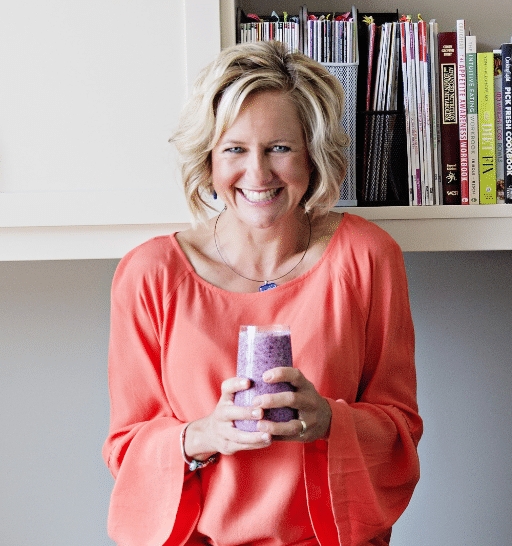

Welcome to the Energize Nutrition blog, where we share evidence-based nutrition content, designed to empower people’s midlife. Take a look around to find information on feeling your best.
If you need more individualized support, reach out to set up a free discovery call with Kristyn Hall.

Battling chronic hunger, poor energy, or inflammation? Discover what this powerful ingredient is and why it might be the solution!
